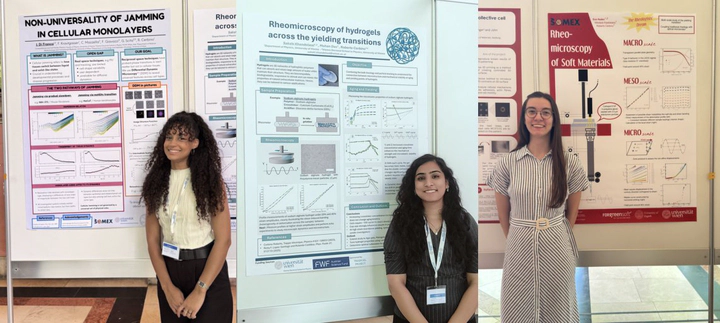Student Poster Presentations at the ÖPG–SPG Joint Conference

Our students showcased their research at the joint conference organized by the Austrian Physical Society (ÖPG) and the Swiss Physical Society (SPG). We are proud to highlight their excellent contributions and congratulate Sakshi Khandelwal on receiving the Best Poster Award 🏆.
PhD Student: Jasmin Di Franco
Poster Title: Non-universality of Jamming in Cellular Monolayers
Abstract:
Phase transitions in cellular collectives, such as jamming, play key roles in biological processes like morphogenesis and wound healing. While traditionally linked to increasing cell density, recent evidence suggests that adhesion forces also influence collective arrest. Our study examines jamming across epithelial and fibroblast cell lines using Particle Image Velocimetry (PIV) and Differential Dynamic Microscopy (DDM). We find significant variability in dynamical behaviors, with some monolayers slowing gradually while others transition from ballistic to diffusive motion. Crucially, motility transitions often correlate with spatial ordering, reflected in the static structure factor. These differences emerge both between and within cell types, challenging the idea of universal jamming. Our findings highlight the need for cell-type-specific frameworks to describe collective arrest in living tissues.
PhD Student: Sakshi Khandelwal
Poster Title: Rheomicroscopy of hydrogels across the yielding transitions
Abstract:
Hydrogels are soft, water-rich polymer networks with widespread applications in biomedicine, soft robotics, and materials engineering. Understanding their mechanical behavior, particularly yielding, the strain amplitude at which their response transitions from solid-like to fluid-like—is essential for improving their reliability and performance. Here, we present preliminary rheomicroscopy results on a model hydrogel system, obtained using both commercial and custom-built rheometer. Our approach, combining classical rheological measurements with simultaneous quantitative microscopy, elucidates how the material responds to applied stress and highlights the onset of mechanical failure. These observations provide insight into the gel’s stress-bearing capacity and lay the groundwork for future strategies to enhance its mechanical resilience and functional adaptability in application-oriented contexts.
MSc Student: Eva Hudec
Poster Title: Rheo-microscopy of Soft Materials
Abstract:
We investigate how microscopic dynamics underpin the bulk rheological behavior of soft materials by integrating microscopy with rheological measurements. By adapting a commercial rheometer for in situ imaging, we visualize structural rearrangements during deformation and recovery. Using echo protocols and recovery rheology, we probe viscoelastic behavior in both commercial and custom samples. Particle tracking and differential dynamic microscopy (DDM) enable us to correlate macroscopic mechanical responses with microscopic motion across different timescales and length scales. This work moves us closer to the rheologist’s dream: directly observing the structures responsible for flow and deformation.